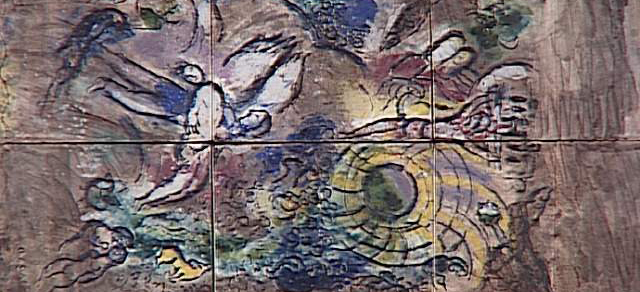The Creation Evidence Museum in Glen Rose, Texas, should not be confused with the Creation Museum, in Petersburg, Ky. Both museums have a Noah’s Ark, but the one in Texas is only a 25-foot replica, while the one in Kentucky claims to be actual size.
Both museums promote a pseudoscientific, young earth creationist explanation of the origin of the universe, based on a hard-not-to-shake-your-head-at literal interpretation of Genesis one and two. Both museums have a lot to work with, because the creation accounts have inspired more goofiness than any other stories in the Bible.

Brett Younger
In the early 1600s, Archbishop James Ussher opened his Old Testament, counted backward and established the first day of creation as Sunday, October 23, 4004 BCE. Remarkably, the archbishop was able to calculate the dates of other biblical events, concluding, for example, that Adam and Eve were driven from Paradise on Monday, November 10, 4004 BCE.
Ussher did not, however, tell us what time of day God began creating. That was left to Reverend John Lightfoot of Cambridge University who, in 1644, concluded God began creating at 9:00 in the morning. Wouldn’t you think God would get to work by 8:30?
Books have been written — and, surprisingly, published — debating the length of a day in Genesis. People have not only asked how vegetation, which is created in verse 11, survived without sunlight, which is created in verse 14, but have been able to keep a straight face while asking these silly questions. Pseudo-scientists have foldout, wall-sized charts, based on the curious suggestion that God planted dinosaur fossils as a dinosaur-sized practical joke.
The purpose of the Creation Evidence Museum, the one in Texas, is to “support a literal six-day creation and arm congregations with the scientific facts to support their faith.”
Those who mistake the poetry in Scripture for the prose of a science textbook miss the point. Genesis is not about when or how but about the far more important questions of who and why.
Genesis imagines God not only as the composer of creation, but the conductor as well, still proclaiming creation good. The heavens continue to declare the glory of God. Scripture invites us to live in appreciation of what God is doing and distress at the destruction of what God is doing.
Greta Thunberg is right to be angry. We have treated the earth harshly. In some cities, breathing the air is the equivalent of smoking 10 cigarettes a day. Rivers are so filled with pesticides and toxic chemicals that the fish cannot be eaten or the water drunk. We have driven countless species into extinction. The rate of disappearance is now more than one per day.
“We have shown disrespect to the Creator by showing disrespect for the creation.”
Glaciers are melting. Sea levels are rising. Temperatures are rising. We have put profits above the planet. We have shown disrespect to the Creator by showing disrespect for the creation. We need to mourn the death of forests, fruitful lands that have become deserts, wild animals left without grass, lands ravaged by war, and people left homeless. Kurt Vonnegut writes, “I really wonder what gives us the right to wreck this poor planet of ours.”
The environmental question may be the most urgent issue of our time. We have to understand that the earth is not ours. The truth proclaimed in Genesis is that the earth is God’s. We live in a borrowed world.
Far from the earth being ours to use and abuse as we wish, we are, as God’s children, called to care for the earth, helping to bring healing to this beautiful, fragile planet. The church has to challenge a society where consumption is the ultimate value and the sacred nature of creation seems forgotten.
We cannot make everything right, but there are small things we can do that add up and remind us of our responsibility. We can step up our recycling — dishtowels instead of paper towels, cloth napkins instead of paper napkins. We can be thoughtful consumers, buying products with as little packaging as possible, reusing grocery bags, avoiding disposable items. We can take our names off junk mail lists.
We can reduce our energy consumption. According to Oxfam, the richest 1% of the world’s population is responsible for more than twice as much carbon pollution as the 3.1 billion people who made up the poorest half of humanity during a critical 25-year period of unprecedented emissions growth. The use of so much of the earth’s energy by a tiny minority of the population is unfair. Altering our lifestyles, even a little, will lower the price the earth pays for our presence.
“Altering our lifestyles, even a little, will lower the price the earth pays for our presence.”
We can live more simply. Learn to enjoy things without owning them. Vote for candidates who work to preserve creation. Teach our children to love the earth. As Dave Foreman writes, “Pay your rent for the privilege of living on this beautiful, blue-green, living earth.”
Creation is a sanctuary charged with the grandeur of God. We love God by loving the land, sky and water. If we look at creation with wonder, we will care for the earth and its creatures because we love God and our neighbors.
For some, the next step is to look at our children and grandchildren and see the future looking back at us. We need to say, “We won’t steal your future. We won’t betray your trust. We’ll take care of the world.”
In one Jewish commentary on the creation story (Ecclesiastes Rabbah 7:13), God guides the first human beings around the Garden of Eden and says: “Look at my creations! See how beautiful they are. I created everything for you. Make sure you don’t ruin my world, because if you do, there will be no one after you to fix it.”
Brett Younger serves as senior minister at Plymouth Church in Brooklyn, N.Y.
Related articles:
Creationism is big business in Northern Kentucky
Creation and the environment: ‘Where does God fit into all this?’ | Analysis by Rick Pidcock
Five book recommendations on creation stewardship for 2023 | Opinion by Don Gordon

